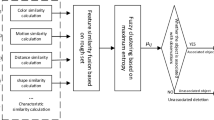Abstract
This work presents the application of neuro-fuzzy techniques to develop a rule-based fuzzy system as an efficient and robust approach for object tracking based on sequences of video images. The fuzzy system is a new approach for data association problems in video image sequences, which uses JPDA formulation adapted to cope with video data peculiarities. The neuro-fuzzy learning algorithm uses examples extracted from a surveillance system of airport surface, including situations with very closely spaced objects (aircraft and surface vehicles moving on apron). The learned fuzzy system ponders update decisions both for the trajectories and shapes estimated for targets with the set of image regions (blobs) extracted from each frame. The inputs of the neuro-fuzzy system are several numeric heuristics, describing the quality of gated groups of blobs and predicted tracks, and outputs are confidence levels used in the update process. Rules are aimed to generate the most appropriate decisions under different conditions, emulating the reasoned decisions taken by an expert, and have been learned by the neuro-fuzzy system. The system performance with real image sequences of representative ground operations is shown at the end.
This work has been funded by Spanish CICYT, TIC2002-04491-C02-01/02
Access this chapter
Tax calculation will be finalised at checkout
Purchases are for personal use only
Preview
Unable to display preview. Download preview PDF.
Similar content being viewed by others
References
U.S. Department of Transportation. FAA. The Future Airport Surface Movement Safety, Guidance and Control Systems: A vision for Transition into the 21st Century. Washington. November 1993.
J. A. Besada, J. Portillo, J. García, J. M. Molina. Image-Based Automatic Surveillance for Airport Surface FUSION 2001. Montreal, Canada. August 2001.
S. Blackman, R. Popoli. Design and Analysis of Modern Tracking Systems. Arlech House. 1999
Z. Ding, H. Leung, L. Hong. Decoupling joint probabilistic data association algorithm for multiple target tracking. IEE Proceedings-Radar, Sonar and Navigation, Vol 146, N°5. pp 251–254. October 1999
J. García, J. A. Besada, J. M. Molina, J. Portillo. Fuzzy data association for image-based tracking in dense scenarios. IEEE International Conference on Fuzzy Systems. Honolulu, Hawaii. May 2002
L. A. Zadeh, Outline of a New Approach to the Analysis of Complex Systems and Decision Processes, Trans, on SMC, Vol. 3, N° 1. January 1973
J. M. Mendel. Fuzzy Logic Systems for Engineering: A Tutorial. Proceedings of the IEEE. Vol. 83. N°3,. pp 345–377. March 1995
JJ Buckley, Y. Hayashi Neural Networks for Fuzzy Systems. Fuzzy Sets and Systems, 71, 265–276. 1995.
V. Matellán, C. Fernández, J. M. Molina, Genetic Learning of Fuzzy Reactive Controllers. Robotics and Autonomous Systems, vol 25, n° 1–2, pp 33–41, 1998.
S. K. Halgamuge, M. Glesner, Neural Networks in designing Fuzzy Systems for Real World Applications. Fuzzy Sets and Systems, 65, 1–12. Wiley, 1994.
N. Tschichoid-Giirman, Generation and Improvement of Fuzzy Classifier with Incremental Learning using Fuzzy Rulenel. Proc. ACM Sym on Applied Computing, Nashville, pp 466–470, 1995.
JSR Jang, ANFTS: Adaptive-network-based Fuzzy Inference Systems. IEEE Transactions on System, Man and Cybernetics 23, 665–685, 1993.
M. Sugeno, An Introductory Survey of Fuzzy Control. Information Science 36, 59–83, 1985.
HR Berenji, P. Khedkar, Learning and Tuning Fuzzy Logic Controllers through Reinforcements. IEEE Transactions on Neural Networks 3, 724–740, 1992.
D. Nauck, R. Kruse, NEFCLASS-a neuro-fuzzy approach for the Clasification of Data. Proc. ACM Sym on Applied Computing, Nashville, pp 461–465, 1995.
D. Nauck, R. Kruse, R. Stellmach New Learning Algorithms for the Nuero-Fuzzy Environment NEFCON-1. Proc. Nuero-Fuzzy Systems’95, armsladt, 357–364, 1995.
Author information
Authors and Affiliations
Editor information
Editors and Affiliations
Rights and permissions
Copyright information
© 2003 Springer-Verlag Berlin Heidelberg
About this paper
Cite this paper
Molina, J.M., García, J., de Diego, J., Portillo, J.T. (2003). Neuro-Fuzzy Techniques for Image Tracking. In: Mira, J., Álvarez, J.R. (eds) Artificial Neural Nets Problem Solving Methods. IWANN 2003. Lecture Notes in Computer Science, vol 2687. Springer, Berlin, Heidelberg. https://doi.org/10.1007/3-540-44869-1_64
Download citation
DOI: https://doi.org/10.1007/3-540-44869-1_64
Published:
Publisher Name: Springer, Berlin, Heidelberg
Print ISBN: 978-3-540-40211-4
Online ISBN: 978-3-540-44869-3
eBook Packages: Springer Book Archive




